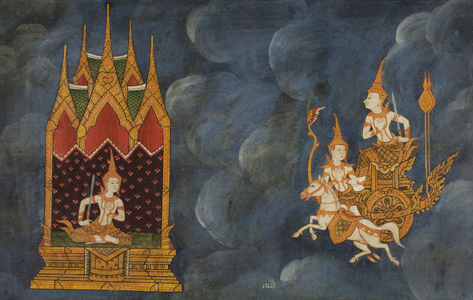Now on view at the San Francisco Asian Art Museum is Emerald Cities: Arts of Siam & Burma, 1775-1950, the first exhibition of its kind to use a systematic approach to present artworks from this region and period.

By Paul Duclos
Published: November, 2009
The exhibition features more than 140 artworks drawn exclusively from the museum’s collection, which is one of the largest and most important collections of 19th century Siamese and Burmese art outside of Southeast Asia. On view are pieces of ornately carved furniture, lavishly decorated miniature shrines, gilded statues, elaborately illustrated manuscripts, colorfully detailed paintings, and mirrored and bejeweled ritual objects. The Asian Art Museum organized Emerald Cities and serves as the exhibition’s exclusive venue.
“All of the artworks on view in Emerald Cities originate from the museum’s extensive collection, demonstrating the quality and depth of the museum’s holdings from Thailand and Burma,” says Jay Xu, Director of the Asian Art Museum. “Through the efforts of Forrest McGill, the museum’s chief curator, and M.L. Pattaratorn Chirapravati, co-curator of the exhibition, Emerald Cities and its accompanying catalogue contribute both to scholarship and public appreciation of the rich and varied artistic traditions of Southeast Asia.”
“A feast for the eyes awaits visitors to Emerald Cities,” says McGill. “The writings and religious thought at the time emphasized the gorgeous, flowering, bejeweled, heavenly city of the gods. This view of a luxurious and fantastical Eden is evident through the artworks on view in the galleries which originate from the three great cities of the time—Bangkok, Mandalay and Rangoon.”
Gangster Era on The Rock
Many of us remember when Native Americans briefly occupied Alcatraz in an effort to reclaim it as a sacred refuge. Then there was proposal floated by Mayor Willie Brown to turn “The Rock” into a casino. Now there is current movement surfacing to make it a “global peace park.”
But despite all that, it remains a monument to human suffering. The hardships were never more pronounced than in the era when Al Capone, Alvin Karpis and George “Machine Gun” Kelly were housed there.
For ferry passengers seeking more than just a quick read on their daily commute, Cultural Currents recommends Alcatraz: The Gangster Years, by David Ward with Gene Kassebaum (University of California Press; 548 pages; $34.95). While written by two emeritus professors of sociology, the book does not suffer from academic pedantry. Indeed, it begins by quoting Alastair Cooke:
“In the middle of San Francisco Bay there rises an island that looks like a battleship ... and when it has not been armed as such, first by the Spaniards and then by the United States Army, it has been a prison of one kind or another. First it was a so-called disciplinary barracks for renegade Indian scouts. Then for captured Filipinos. And always for army traitors. The Spanish lieutenant who discovered it in 1775 might well have called it the Alcazar if he had not been struck by clouds of pelicans that floated around it. So he called it after the bird itself—Alcatraz.”
Mr. Duclos writes “Cultural Currents” every month and blogs about the arts at paulduclosonsanfranciscoculture.blogspot.com.

